


 Today is a bittersweet day for Hammockites, as we bid a happy retirement to Bill Hudgins, a brilliant writer and editor and equally brilliant friend. After graduating from Columbia University in 1972 (get him to tell you a story about NYC in those days!), he honed his ability to file tight, smart stories on deadline at newspapers such as the Birmingham (Ala.) Post-Herald, Cleveland (Tenn.) Daily Banner and Nashville Banner. His next career turn was into public relations when Rex Hammock recruited him to join Buntin Public Relations, then a start-up subsidiary of the Buntin Group, a regional advertising and marketing firm.
Today is a bittersweet day for Hammockites, as we bid a happy retirement to Bill Hudgins, a brilliant writer and editor and equally brilliant friend. After graduating from Columbia University in 1972 (get him to tell you a story about NYC in those days!), he honed his ability to file tight, smart stories on deadline at newspapers such as the Birmingham (Ala.) Post-Herald, Cleveland (Tenn.) Daily Banner and Nashville Banner. His next career turn was into public relations when Rex Hammock recruited him to join Buntin Public Relations, then a start-up subsidiary of the Buntin Group, a regional advertising and marketing firm.
 For four years, American Spirit* has dedicated its March/April issue to Women’s History Month. It’s a particularly enjoyable issue to write, edit and design in partnership with the Daughters of the American Revolution since it gives us a chance to find and promote little-known stories of fascinating women of early America.
For four years, American Spirit* has dedicated its March/April issue to Women’s History Month. It’s a particularly enjoyable issue to write, edit and design in partnership with the Daughters of the American Revolution since it gives us a chance to find and promote little-known stories of fascinating women of early America.
One of those women is a Cherokee “Beloved Woman” named Nan-ye-hi, an influential leader and peacekeeper during a time of great upheaval in the Cherokee Nation. Despite my living in Tennessee–her home and that of her ancestors–for the past 10 years, I had never even heard of Nan-ye-hi until the Nancy Ward DAR Chapter (named after her English name) suggested researching her life for this issue. It was a privilege to share that research with readers.
Our cover was designed to highlight Nan-ye-hi and two of the other diverse and distinguished women featured in this issue. Illustrator Antonio Rodrigues used organic shapes and earthy colors to illuminate Elizabeth Freeman, the former slave who helped abolish slavery in Massachusetts, St. Elizabeth Ann Seton, a pioneer in Catholic education who became the first U.S. citizen to be canonized, and Nan-ye-hi. The subtle background script that fleshes out the illustrations underscores one of American Spirit’s goals: to faithfully record these early American women’s remarkable stories and convey their importance to modern readers.
Another feature is excerpted from Nancy Rubin Stuart’s book, Defiant Brides: The Untold Story of Two Revolutionary-Era Women and the Radical Men They Married. Stuart details the moments that Lucy Flucker Knox and Peggy Shippen Arnold met their Revolutionary husbands Henry Knox and Benedict Arnold, and hints at ways the women’s initially parallel lives eventually diverged.
It’s Mardi Gras season, so it’s fitting that we travel to Louisiana for two stories: Our Historic Homes department visits Laura Plantation, a French Creole sugar plantation that was run by several strong-willed women in the 19th century, and Spirited Adventures checks in on Natchitoches, the oldest permanent settlement in the Louisiana Purchase.
*For more than a decade, Hammock has been honored to assist the National Society Daughters of the American Revolution in publishing their award-winning magazine. Anyone can subscribe here.
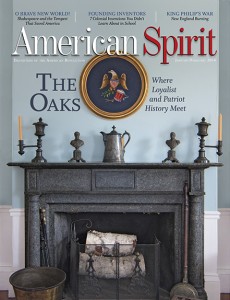 Every issue of American Spirit* invites readers to learn more about a historic home–and its owners–particularly those with connections to the Colonial or Early American period. Gracing the January/February cover is The Oaks, a Worcester, Mass., home finished at the end of the Revolution by Judge Timothy Paine and later occupied by his son, Dr. William Paine. Both Paines were Tories, but, ironically, the home is now owned and preserved by the Colonel Timothy Bigelow DAR Chapter, named for the Revolutionary minuteman, prisoner of war and military commander.
Every issue of American Spirit* invites readers to learn more about a historic home–and its owners–particularly those with connections to the Colonial or Early American period. Gracing the January/February cover is The Oaks, a Worcester, Mass., home finished at the end of the Revolution by Judge Timothy Paine and later occupied by his son, Dr. William Paine. Both Paines were Tories, but, ironically, the home is now owned and preserved by the Colonel Timothy Bigelow DAR Chapter, named for the Revolutionary minuteman, prisoner of war and military commander.
Another feature honors the French-born Patriot Comte de Rochambeau. He forged an effective partnership with George Washington and played an integral role in the British defeat at the Siege of Yorktown.
We delve into law and order, early-American-style, for a feature on Virginia statesman George Wythe. We investigate the mysterious circumstances of this Patriot’s painful death, probably at the hands of his ne’er-do-well grandnephew.
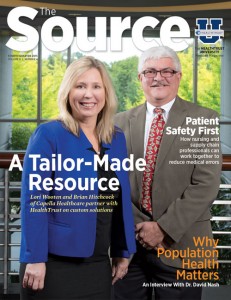 Population health was foremost on our minds as we prepared the Q4 issue of The Source, the magazine we help HealthTrust publish for healthcare supply chain professionals. Healthcare systems and physicians groups are developing new programs aimed at population health management, a systematic approach to addressing the preventive, high-risk and chronic care needs of patients, with a goal of minimizing costly interventions like emergency room visits, hospitalizations and readmissions. We interview Dr. David Nash, of the Jefferson School of Population Health in Philadelphia, on this healthcare paradigm shift. As the founding dean of the first designated school of population health in the country, Nash is considered one of the leading experts in the field.
Population health was foremost on our minds as we prepared the Q4 issue of The Source, the magazine we help HealthTrust publish for healthcare supply chain professionals. Healthcare systems and physicians groups are developing new programs aimed at population health management, a systematic approach to addressing the preventive, high-risk and chronic care needs of patients, with a goal of minimizing costly interventions like emergency room visits, hospitalizations and readmissions. We interview Dr. David Nash, of the Jefferson School of Population Health in Philadelphia, on this healthcare paradigm shift. As the founding dean of the first designated school of population health in the country, Nash is considered one of the leading experts in the field.
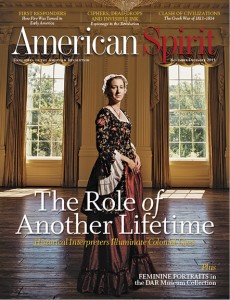
American Spirit* visited the American Village, a history and civics education center in Montevallo, Ala., for our November/December 2013 cover story profiling historical interpreters. (This editor grew up less than a mile away from the American Village, and it’s her family’s favorite spot for Fourth of July fireworks and other patriotic events.) The American Village re-enactors and others spotlighted in our story exhibit an extraordinary commitment to historical detail. That commitment to authenticity is best expressed by this quote from Patricia Bridgman, who plays Abigail Adams at Adams National Historical Park in Quincy, Mass., and at the Abigail Adams birthplace in Weymouth, Mass.
“I sweep my bangs up into a pompadour, eschew makeup, lace myself into stays, don a bum roll [a support, such as a hoop or pillow, worn under a skirt], petticoats and gown, along with silk stockings and reproduction shoes, and I’m ready to go,” Ms. Bridgman says. “The one question all re-enactors get is, ‘Aren’t you hot in that?’ The 21st-century answer is, ‘Damn straight,’ but Abigail says, ‘I am well accustomed to it, madam.’”
 Don’t you want to grab one of the crisp red apples that grace the cover of the September/October issue of American Spirit*? Our feature takes readers through the history of how apples became “our democratic fruit.” Just as they set down their own roots on American soil, settlers bringing seeds to the New World in 1620 carefully nurtured the fruit-bearing trees, and it wasn’t long before apples became a staple of the nation’s diet. Today they’re a unique symbol of our cultural heritage.
Don’t you want to grab one of the crisp red apples that grace the cover of the September/October issue of American Spirit*? Our feature takes readers through the history of how apples became “our democratic fruit.” Just as they set down their own roots on American soil, settlers bringing seeds to the New World in 1620 carefully nurtured the fruit-bearing trees, and it wasn’t long before apples became a staple of the nation’s diet. Today they’re a unique symbol of our cultural heritage.
Revolutionary spirit (often aided by a “flagon,” or pitcher, of apple cider) certainly was fomented in Colonial taverns. We talk with members of Flagon and Trencher, a lineage society that celebrates tavern keepers licensed prior to 1776 and honors their spicy ancestors’ unique contributions to the Revolution.
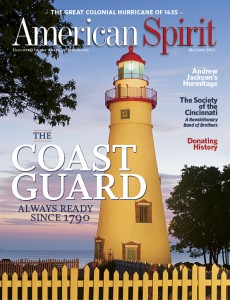 In our May/June issue of American Spirit, the national magazine of the Daughters of the American Revolution (DAR)*, we remember an often-unsung branch of our Armed Forces: The United States Coast Guard. In our cover feature we detail the wide-ranging history of Coast Guard, which was originally created in 1790 to raise revenues and pull the nation out of debt. It has evolved into a guardian of our shores, a protector of our borders and an “Always Ready” life-saving service. As president George H.W. Bush said, “No branch of service has been in the business of saving lives longer than the Coast Guard. … No other branch does more to protect our environment. Few do as much to defend our homeland against the shadowy threats of illegal drugs and, now, terrorism. … This remarkable institution … is so clearly indispensable to America’s future.”
In our May/June issue of American Spirit, the national magazine of the Daughters of the American Revolution (DAR)*, we remember an often-unsung branch of our Armed Forces: The United States Coast Guard. In our cover feature we detail the wide-ranging history of Coast Guard, which was originally created in 1790 to raise revenues and pull the nation out of debt. It has evolved into a guardian of our shores, a protector of our borders and an “Always Ready” life-saving service. As president George H.W. Bush said, “No branch of service has been in the business of saving lives longer than the Coast Guard. … No other branch does more to protect our environment. Few do as much to defend our homeland against the shadowy threats of illegal drugs and, now, terrorism. … This remarkable institution … is so clearly indispensable to America’s future.”
Even with today’s high-tech weather radars and forecasting tools, extreme weather can uproot thousands of people, destroy homes and buildings and wreak havoc, as proven by the recent devastating tornadoes in Oklahoma and Hurricane Sandy on the East Coast. But what if such a storm came with absolutely no warning? That’s what happened in 1635,when a massive hurricane hit the coast of New England with winds estimated at 130 miles an hour, making it possibly the strongest hurricane ever to hit the region. Our feature shows how early Americans dealt with such severe weather events — and tried to make sense of the natural world.
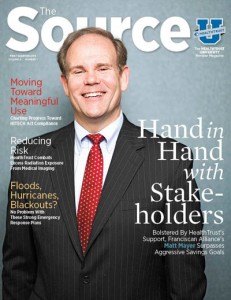 Hammock partners with HealthTrust, one of the country’s leading health-care group purchasing organizations, to publish The Source, a quarterly magazine for supply chain managers, health-care executives, pharmacists and clinicians from a variety of disciplines. Q1’s cover story featured Matt Mayer of Franciscan Alliance, who, with HealthTrust’s help, was able to save $28 million in supply chain costs in 2012.
Hammock partners with HealthTrust, one of the country’s leading health-care group purchasing organizations, to publish The Source, a quarterly magazine for supply chain managers, health-care executives, pharmacists and clinicians from a variety of disciplines. Q1’s cover story featured Matt Mayer of Franciscan Alliance, who, with HealthTrust’s help, was able to save $28 million in supply chain costs in 2012.
Finding members such significant savings, especially in today’s squeezed health-care environment, is one of HealthTrust’s biggest priorities. The magazine’s aim is to showcase practical strategies and best practices for duplicating those kinds of success stories in hospitals and care facilities nationwide.
HealthTrust members receive the print edition, but anyone can view archives since 2008 on The Source‘s website. Take a look at the entire Q1 issue here.
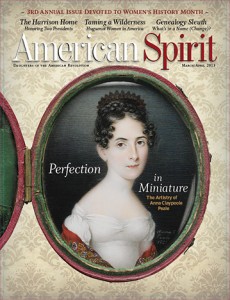 American Spirit, the national magazine of the Daughters of the American Revolution (DAR)*, has a strong track record of bringing to light stories about brave and groundbreaking women of history whose lives aren’t very familiar to most people.
American Spirit, the national magazine of the Daughters of the American Revolution (DAR)*, has a strong track record of bringing to light stories about brave and groundbreaking women of history whose lives aren’t very familiar to most people.
Nowhere is that focus more apparent than in the magazine’s third annual issue devoted to Women’s History Month.
The cover feature looks at the lives of Anna Claypoole Peale and Sarah Miriam Peale. The sisters not only found distinction as highly skilled 19th-century portrait artists, but they also were remarkable in another respect: They were able to support themselves financially in an age when women were supposed to be homemakers, not artisans.
Though Irish immigrant Margaret Haughery’s early life was marred by tragedy and she had no formal schooling, she persevered to become a successful entrepreneur in 19th-century New Orleans. This issue includes a feature examining how she dedicated her life to helping orphans in that disease-plagued city, inspiring many of her fellow citizens to call her the Angel of the Delta.
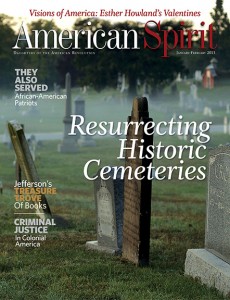 Restoring our nation’s cemeteries and preserving the stories they tell about our history and genealogy are high priorities for our client, the Daughters of the American Revolution. We honor that commitment in the January/February 2013 issue of American Spirit as we highlight historic cemeteries of various sizes, many of them once ravaged by time, natural elements and neglect, that have been rehabilitated by dedicated volunteers.
Restoring our nation’s cemeteries and preserving the stories they tell about our history and genealogy are high priorities for our client, the Daughters of the American Revolution. We honor that commitment in the January/February 2013 issue of American Spirit as we highlight historic cemeteries of various sizes, many of them once ravaged by time, natural elements and neglect, that have been rehabilitated by dedicated volunteers.
To commemorate February’s Black History Month, the issue also examines unsung African-Americans, both slaves and freemen, who contributed to the Revolutionary cause. One story is especially dramatic: In the weeks leading up to the climactic battle at Yorktown, Va., General George Washington received a steady stream of crucial intelligence from a highly placed spy who worked for Washington’s foe, Lord Cornwallis. That Washington had a double agent literally within the British commander’s tent is remarkable in itself. What is even more remarkable is that the spy was a Virginia slave named James Armistead, whose dangerous duty would eventually earn him his freedom.
And February 14 is on our minds as we remember Esther Howland, a Mayflower descendant who was known as the mother of the American valentine.